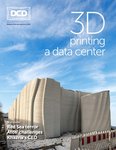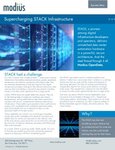In today's digitally interconnected landscape, data centers stand as the bedrock of modern business operations, where reliability and uptime reign supreme. One data center outage caused by fire and exacerbated by water damage disrupted Google’s Cloud service, impacting Western Europe, Japan, India, Indonesia, and South Carolina, while a Microsoft Azure outage prevented millions of users from accessing Outlook and Teams.
The financial repercussions of even the briefest disruption continue to mount, with Gartner's latest findings revealing an average cost of $5,600 per minute of IT downtime. With data creation growth projections reaching over 147 zettabytes this year, data centers will continue to serve as the foundational infrastructure supporting critical applications and services. Beyond financial losses, downtime can result in reputational damage with customers and legal implications.
Ensuring the reliability of data centers is paramount due to their central role in today’s digital age. From proactive risk mitigation to operational optimization, what strategies and cutting-edge technologies are poised to bolster data center reliability in response to these formidable challenges?
The challenges in the current landscape
Data centers face numerous challenges in maintaining reliability. Aging infrastructure such as servers, network switches, and other hardware resources pose risks and need strategic upgrades. Cybersecurity threats are ever-evolving, demanding robust measures. Scalability and flexibility challenges emerge as businesses grow, demanding agile and flexible solutions. Moreover, data centers are also susceptible to weather-related incidents, such as extreme temperatures, storms, or natural disasters, which can disrupt operations and jeopardize data integrity. Network failures, whether caused by technical glitches or external factors, further contribute to the complexity of maintaining uninterrupted services.
Strategies for enhancing data center reliability
For seasoned data center operators dedicated to fortifying their infrastructure against potential disruptions, the top strategies require a meticulous blend of industry standards adherence, advanced technologies integration, and proactive risk mitigation tactics.
Firstly, collaboration with industry forums is imperative. Engaging with such forums, like IEEE Industry Application Society’s Industrial and Commercial Power System Department and its Data Center Subcommittee, that support many aspects of data center design and operation, facilitates a deep understanding of evolving industry standards and best practices. By actively participating in discussions and knowledge-sharing sessions, data center operators can glean invaluable insights into emerging threats and vulnerabilities. This collaborative ethos fosters a culture of continuous improvement, where data center practices are refined in lockstep with industry advancements.
Moreover, regular audits and assessments, conducted with a sharp focus on these standards, serve as diagnostic tools for pinpointing vulnerabilities and performance gaps. These assessments should encompass not only technical infrastructure but also operational procedures and personnel training protocols, ensuring a holistic approach to reliability enhancement.
In tandem with standards adherence, the implementation of redundancy and resilience measures is a linchpin of data center reliability. Deploying redundant power supplies, networking components, and storage arrays offers a safety net against hardware failures. Incorporating failover mechanisms at both the hardware and software levels ensures seamless continuity of operations in the event of component failures. Geographic redundancy, achieved through distributed data centers or cloud-based architectures spanning multiple regions, further fortifies resilience against localized disasters and network outages. However, it is essential to strike a balance between redundancy and cost-effectiveness, optimizing resource allocation to maximize uptime without unnecessary expenditure.
In the realm of advanced technologies, the integration of predictive analytics driven by artificial intelligence (AI) and machine learning (ML) represents a transformative approach to proactive issue detection and mitigation.
By harnessing historical data patterns and real-time telemetry, AI and ML algorithms can identify anomalous behavior indicative of potential failures or performance degradation. These predictive insights empower operators to intervene proactively, preempting downtime and optimizing resource utilization. From predicting hardware failures based on early warning signs to optimizing workload distribution for peak efficiency, predictive analytics hold immense potential for enhancing data center reliability in an increasingly dynamic operating environment. In order to realize the benefits of such technologies, the appropriate hardware for data collection must be embedded into the data center infrastructure.
Robust security measures constitute another cornerstone of data center reliability, safeguarding against both cyber threats and physical intrusions. Cybersecurity protocols should encompass multifaceted defense strategies, including perimeter security, network segmentation, encryption, and intrusion detection systems. Regular vulnerability assessments and penetration testing help identify and remediate potential weaknesses before they can be exploited by malicious actors. Physical security measures, such as access controls, surveillance systems, and environmental monitoring, bolster protection against unauthorized access and environmental hazards. Additionally, robust disaster recovery and business continuity plans should be in place to ensure swift recovery in the event of a security breach or natural disaster.
Automation and orchestration technologies offer further avenues for enhancing data center reliability by streamlining operations and reducing the risk of human errors.
By automating routine tasks such as provisioning, configuration management, and resource allocation, operators can minimize the potential for manual errors and inconsistencies. Orchestration frameworks, powered by automation scripts and workflows, enable seamless coordination and synchronization of complex workflows spanning multiple systems and environments. However, it is crucial to strike a balance between automation and human oversight, ensuring that critical decisions and interventions remain within the purview of skilled operators.
Lastly, designing scalable architectures is essential for ensuring long-term reliability and adaptability to evolving business requirements. Scalability encompasses not only the ability to accommodate growth in data volume and processing demands but also the flexibility to integrate emerging technologies and architectures seamlessly. Modular design principles, such as containerization and microservices architecture, facilitate agility and scalability by decoupling components and enabling independent scaling. Cloud-native architectures offer inherent scalability and resilience, leveraging distributed computing resources and elastic scaling capabilities to meet fluctuating workloads dynamically.
Ultimately, data center reliability is a multifaceted challenge that requires an integrated approach. As technologies evolve, data center leaders must stay proactive, adapting strategies to maintain peak performance for sustained reliability and uptime.
Ensuring data center reliability in today's dynamic operating landscape demands a multifaceted approach encompassing adherence to industry standards, advanced technology integration, and proactive risk mitigation tactics. By leveraging a combination of collaborative engagement with industry forums, meticulous standards adherence, advanced technologies integration, and proactive risk mitigation tactics, data center operators can fortify their infrastructure against potential disruptions and safeguard business continuity in an increasingly interconnected world.





